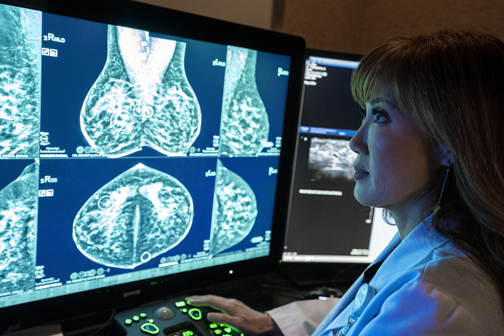
Dr. Mary Yamashita, cancer diagnostic radiology, USC Verdugo Hills Hospital, advises women at high risk for cancer to start screening at age 30.
Talking to your doctor about breast density may be key in detecting this disease.
By Mary O’KEEFE
October is Breast Cancer Awareness Month. For some, this is the time when women, and some men, have mammograms.
A mammogram is an X-ray picture of the breast. The American Cancer Society suggests that women between the ages of 40 and 44 begin annual screenings for breast cancer by having a mammogram.
“Women at high risk for cancer should start screening at age 30 and they need to add breast MRIs to [their examination],” said Dr. Mary Yamashita, cancer diagnostic radiology, USC Verdugo Hills Hospital.
More women may have been recently notified that they have dense breasts and therefore would require a whole breast ultrasound to detect the presence of cancer. Some of the women who have been told this are surprised to learn they have dense breasts, then are concerned about what that might mean.
California law requires patients whose breast density is defined as
“heterogeneously dense” or “extremely dense” receive notification that their mammogram shows they have dense breasts. Though dense breasts are common and not abnormal receiving this notification, either through mail, email or from a doctor, can be a little off-putting.
Yamashita said a lot of confusion and concern came from the way women were being notified.
“The law went into effect without [legislators] thinking about what it actually means,” she said. “Thirty-eight states have these notification laws. Some states’ insurance will cover [the ultrasound] but other states’ insurance doesn’t cover.”
She added that having a dialogue with a medical professional about dense breasts is important. The good news is in September 2024 all breast centers that perform mammograms will have to send out letters letting people know that they either have dense breasts or non-dense breasts.
So what are dense breasts? Well, it has nothing to do with the size or feel of the breast.
“Breasts are made up of fat and fiber glandular tissue, where milk tissues are,” Yamashita said.
Some breasts have more fat while others are more fibrous and glandular and are less fatty. The reason this is important is due to how breasts appear on mammograms. Dense breasts – those with higher amounts of fibrous and glandular tissue – appear white on mammograms while those that are fatty or are non-dense appear dark. On mammograms cancer also appears white so women whose mammograms appear white are asked to have a full breast ultrasound, which gives a clearer view of the breast and may be a better tool to detect cancer.
“There is a three-to-five fold increase in the risk [of breast cancer] with women [who] have dense breasts as [opposed to] those [who] have fatty breasts,” Yamashita said.
Although for some women this may be the first they’re hearing about dense and non-dense breasts this information has been known for a long time.
“What has been lacking is [having] the medical community coming together,” Yamashita said.
Knowing what type of breast tissue the patient has can be the difference between early detection of cancer and learning that a patient has a more advanced stage of cancer.
“I did what the medical field and the countless number of cancer advocacy groups told me. I ate healthily, did monthly self-exams, exercised daily, had yearly mammograms and had no first-degree relative with breast cancer. Little did I know at the time that there was information about my health which impacts my life outcomes that was being kept from me – the patient – and others like me,” stated Dr. Nancy Cappello on areyoudense.org. “I call it the best-kept secret – but it was known in the medical community. I have dense breast tissue – and women like me (two-thirds of pre-menopausal and a quarter of post menopausal) have less than a 48% chance of having breast cancer detected by a mammogram. In November 2003 I had my yearly mammogram and my ‘happy gram’ report that I received stated that my mammogram was ‘normal’ and that there were ‘no significant findings.’ Six weeks later at my annual exam in January, my doctor felt a ridge in my right breast and sent me for another mammogram and an ultrasound. The mammogram revealed ‘nothing’ yet the ultrasound detected a large 2.5 cm suspicious lesion, which was later confirmed to be stage 3c breast cancer, as the cancer had metastasized to 13 lymph nodes.”
Yamashita said women 40 and over and are at lower risk of breast cancer, for example there is no history of breast cancer in their family, should have a mammogram every year. Those who have dense breasts should also have the full breast ultrasound – yes, even though an ultrasound is performed a mammogram is still needed.
“Mammograms will never go away,” she said.
People should talk to their doctor to find out if they have dense or non-dense breasts.
For more information, visit areyoudense.org or the American Cancer Society www.cancer.org or USC VHH https://tinyurl.com/h8kdnktf.
